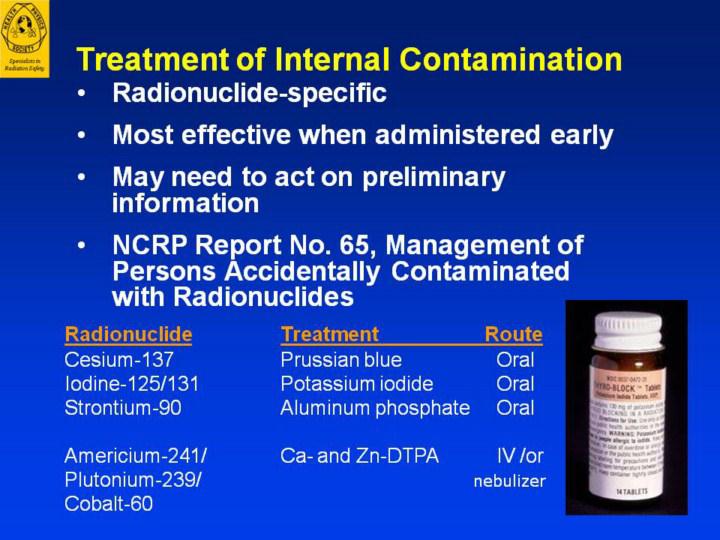| front |1 |2 |3 |4 |5 |6 |7 |8 |9 |10 |11 |12 |13 |14 |15 |16 |17 |18 |19 |20 |21 |22 |23 |24 |25 |26 |27 |28 |29 |30 |31 |32 |33 |34 |35 |36 |37 |38 |39 |40 |41 |42 |43 |44 |45 |46 |47 |48 |49 |50 |review |
 |
Treatment of Internal Contamination
•Deposition
of radioactive materials in the body (i.e., internal contamination), is
a time-dependent, physiological phenomenon related to both the physical
and chemical natures of the contaminant.
•The
rate of radionuclide incorporation into organs can be quite rapid.
Thus, time can be critical and treatment (decorporation) urgent.
•Several
methods of preventing incorporation (e.g., catharsis, gastric lavage)
might be applicable and can be prescribed by a physician.
•Some
of the medications or preparations used in decorporation might not be
available locally and should be stocked.
•NCRP
Report No. 65,
Management of Persons Accidentally Contaminated with Radionuclides,
addresses the strategies to limit the exposure from internal
contamination by radioactive materials.
Radiation Protection Dosimetry
published a
Guidebook for the Treatment of Accidental Internal Radionuclide
Contamination of Workers
(1992) that provides additional information on patient management.
•In
January 2003, the Food and Drug Administration (FDA) determined that
Prussian blue had been shown to be safe and effective in treating people
exposed to radioactive elements such as Cesium-137.
•In
August 2004, the FDA determined that two drugs, pentetate calcium
trisodium injection (Ca-DTPA) and pentetate zinc trisodium injection
(Zn-DTPA), are safe and effective for treating internal contamination
with plutonium, americium, or curium. The drugs increase the rate of
elimination of these radioactive materials from the body.
|